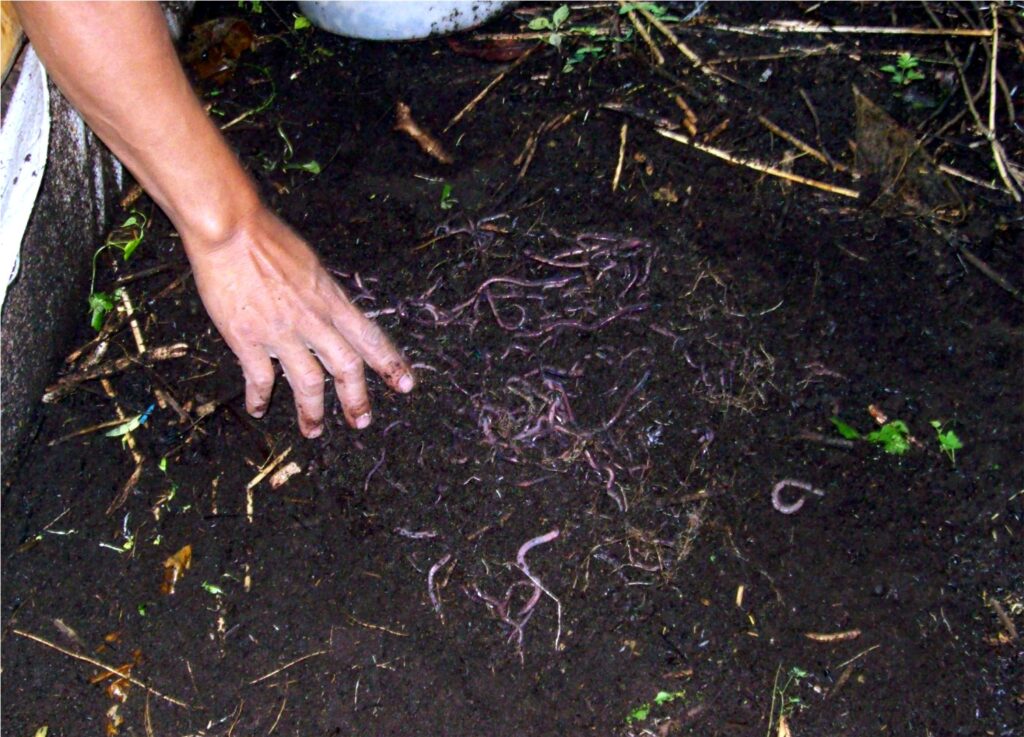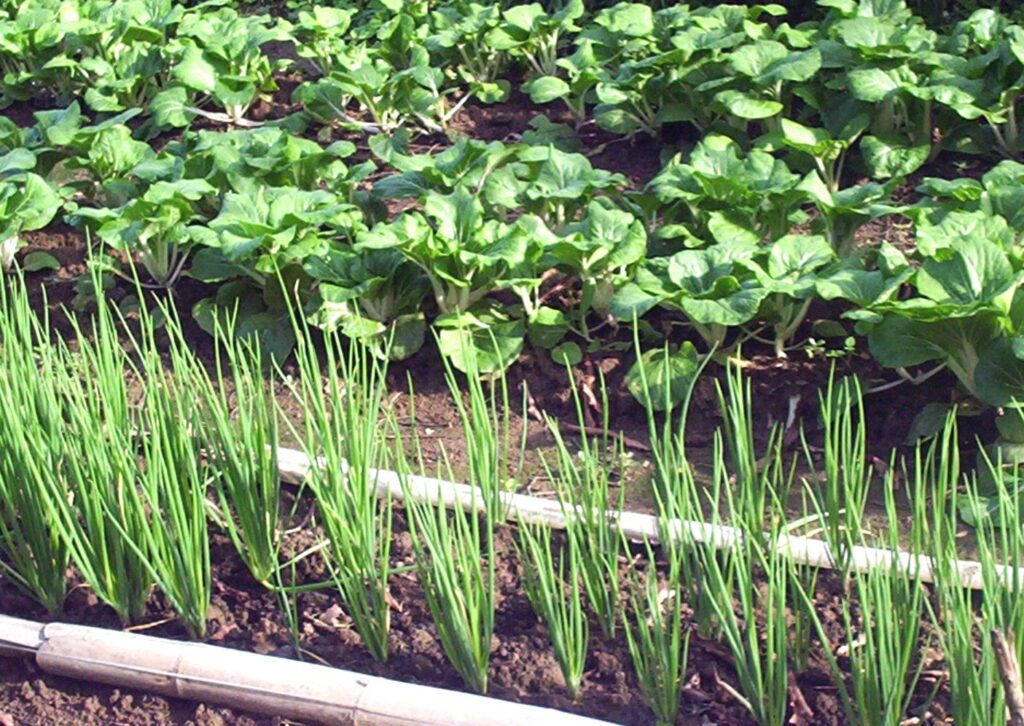Text and Photos by Henrylito D. Tacio
Because of their ability to feed on soil and enrich it with humus, Greek philosopher Aristotle described earthworms as the “intestines of the earth.”
This description has been supported by naturalist Charles Darwin. In his report, “The Formation of Vegetable Mould through the Action of Earthworms, with Observation on their Habitats,” he estimated that worms add one inch of topsoil every five years.
Before Darwin published his report in 1881, little was known about the characteristics of earthworms. Their importance was recognized only as related to agriculture. Today, earthworms are known to be multi-purpose organisms. They are significant ingredients in waste-recycling, especially urban and industrial wastes. They can be used as substitutes for imported feeds for chickens and fish. They are also utilized in crop production.
“With the cost of commercial feed and fertilizer still increasing,” said Dr. Rafael D. Guerrero III, an academician with the National Academy of Science and Technology (NAST), “our farmers are finding that they can earn more if they use earthworm meal as a substitute for fish meal, and humus to fertilize their crops.”
Vermiculture is what experts call the system of raising earthworms (vermis in Latin). In the United States, the vermiculture for the production of fish bait is an old industry. But it was not until in the 1960s that vermicomposting, the use of earthworms for compost or organic fertilizer, became popular.
In the Philippines, vermicomposting started in the 1970s with studies conducted by researchers of the Central Luzon State University in Munoz, Nueva Ecija. However, it did not take off as expected. It was not until Guerrero took a second look at the technology that it started to gain popularity.
Dr. Guerrero wanted to utilize vermicomposting to improve soil fertility, reduce costs and mitigate pollution in the Philippines. “We have a robust agricultural economy with our extensive land and water resources,” he pointed out. “The production of crops such as rice, coconut and sugarcane, along with fisheries (aquaculture), is the mainstay of our agricultural base.”
He found out that one of the major constraints in the production of crops and fish in the country was the high cost of inputs, particularly imported chemical fertilizers for crop production and feeds for aquaculture. Of environmental concern was the widespread burning of crop residues such as rice straw and sugarcane trash.
“About 24 million tons of rice straws are generated annually,” Dr. Guerrero said. “Livestock manure poses additional challenges. Approximately 28 million tons per year are generated, and improper discharge into water bodies is causing aquatic pollution and fish kills.”
So, he thought of turning these wastes into organic fertilizer using vermicomposting or the process of converting biodegradable wastes from households and farms into compost (organic soil) through the action of earthworms.
Earthworm species
Dr. Sam James, a leading authority on earthworms, points out that more than 4,000 species of earthworms have been identified, and the Philippines is home to over 400 species, both endemic and introduced.
For vermiculture, the following species are recommended: red worm (Lumbricas rubellus), manure worm (Eisenia foetida), India blue worm (Perionyx excavatus), and African nightcrawler worm (Eudrilus eugeniae).
Of these species, Dr. Guerrero recommended the African nightcrawler (introduced in 1982 from Germany). It is said to be the most efficient for vermicomposting under Philippine conditions. “It matures in six weeks and can be bred as often as once a week,” he said.
Whatever species, earthworms thrive in damp soil and freshwater. They vary in size from under one millimeter long to over seven feet long.
Earthworms are soft-bodies and “cold-blooded” creatures that have no special body covering like hairs and scales. They feel and breathe through their skin. While most earthworms are hermaphrodites (individuals with both male and female sex organs), some are pathenogenetic (capable of reproducing without fertilization).
“With the aid of aerobic microorganisms (that is, bacteria and fungi), earthworms digest processed organic materials under favorable temperature and moisture conditions,” Dr. Guerrero further said. “The materials that pass through the digestive tract of the earthworms come out in a texturized, sanitized and deodorized form of castings known as vermicompost.”
Vermicompost is richer in many nutrients than compost produced by other composting methods. It is also rich in microbial life which helps break down nutrients already present in the soil into plant-available forms. Unlike other compost, worm castings also contain worm mucus which keeps nutrients from washing away with the first watering and holds moisture better than plain soil.
Vermicomposting
The principles of vermicomposting are the same as those for ordinary compost production. The three basic requirements are: the carbon to nitrogen (C/N) ratio of the compostible materials, water, and oxygen. The C/N ratio refers to the balance of the amounts of sugars and starch (carbohydrate) and protein compounds (nitrogenous) in the materials to be composted required by the earthworms for energy and growth.
Water and oxygen are also needed by the earthworms for their development.
In his Handbook of Vermicompost and Vermimeal Production and Utilization, Dr. Guerrero shared the following tips:
· Select an area that is shaded (earthworms shy away from strong light), flood-free (they crawl out of flooded areas), and accessible to water supply and source of compost materials.
· Utilize composting materials coming from farms (such as rice straw and animal manures), garden (dried leaves and freshly-mowed grass), or kitchen (vegetable trimmings and fruit peelings).
· Use dry or fresh materials in preparing the beds (composting units). Pulverize coarse and dry materials like manures and shred freshly-cut grass to hasten microbiological action. “While pig or cow manure can suffice for vermicomposting because of its C/N ratio, it may be necessary to mix different materials (example: rice straw and manure) with appropriate proportions to achieve a C/N ratio between 25-35,” Dr. Guerrero explained.
· Stock the beds with earthworms. A kilogram of worms is stocked per square meter of outdoor bed. The number of worms per kilo can range from one to four thousand, depending on the average worm weight.
· Maintain the beds. With proper bed preparation and work stocking, the vermicomposting period should not be more than a month. Check predators. Sustain the moisture level of the materials (at least 60%).
· Harvest the vermicompost when most of the materials have been consumed by the earthworms.
Higher yield, better income
In Davao del Sur, one organization that is promoting vermicomposting is the Mindanao Baptist Rural Life Center (MBRLC) Foundation, Inc. “We found out that vermicompost is good for vegetables and even fruit trees,” said Ian Ogatis, the person in-charge with the center’s vermicomposting.
In an experiment conducted on eggplant, results showed that a combination of vermicompost at 100 grams per pot (6.2 tons per hectare) and 50 percent of the recommended chemical fertilizer application gave a significantly higher yield (15 percent more) of eggplant fruits, compared to that with 100 percent chemical fertilization, after 120 days from planting.
Vermimeal
Earthworm biomass can also be processed into an earthworm meal called vermimeal. “While still considered a by-product of vermicomposting, earthworms are an excellent source of animal protein for livestock and fish feeds,” Dr. Guerrero said. “With the widespread application of vermicomposting in the country, we hope that the mass production of worms will warrant the development of a viable vermimeal production industry.”
Dr. Guerrero reported that the use of vermimeal in tilapia feeding in a study gave tilapia better weight gain, survival rate and feed conversion compared with fish meal. When incorporated in the feed of poultry, it was found that vermimeal can replace fish meal as an animal protein source. “The protein of earthworm is more digestible than that of fish meal,” he said.
Forest denudation
Another importance of earthworms: they can be used as indication of the level of forest denudation brought about by logging.
According to Dante Flores, an earthworm expert from De La Salle University (DLSU), logged forests usually carry a lot of the Brazilian worms. Brazilian worms are invasive species that practically live in any type of habitat. They originate from the lowland soils that its presence in mountainous areas usually signals human transfer in logged areas after the replanting of new trees using lowland soil.
Brazilian earthworms, Flores said, also tend to contribute to the susceptibility of logged areas for flash flooding. He explained that the excreta of this particular species of earthworm tend to close soil and make it more compact so that water absorption becomes slow.
“Usually, it’s the endemic species which contribute to better soil absorption. While the foreign Brazilian worm species make it compact. Most of the areas we checked in our study are now invaded with the foreign species. This indicates high denudation and logging activity, which is not good for the soil,” he pointed out.
Medicinal purposes
“Over 40 kinds of prescriptions for medicines from earthworms are known in the ancient medical journals of China,” Dr. Guerrero said.
It has been claimed medicines taken from earthworms have antipyretic, anesthetic, antihistamine, anti-hypertensive and anti-inflammatory properties. In modern medicine, clinical trials are said to have been conducted in assessing the efficacy of recently discovered pharmaceuticals from earthworms such as an enzyme termed lumbrokinase that dissolves thrombi (blood clots) in the blood vessels of humans. An antibacterial peptide in the ‘E. fetida’ and lectins in the E. eugeniae have also been found recently.
“There is a commercial product from China that is sold in local drugstores with the brand name ‘Plasmin,’” Dr. Guerrero said. “Marketed as a food supplement, it is said to contain natural enzymes from earthworms for dissolving blood clots.” – ###




